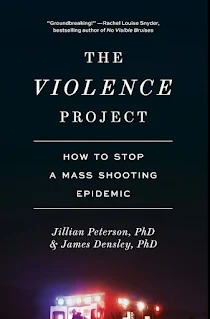The Violence Project
How to
Stop A
Mass
Shooting Epidemic
By
Reviewed by
Most of the time, mass
shootings command the top spot on the evening news. By now the sequence of
covering the crime scene is familiar—too familiar.
Jillian
Peterson and James Densley have studied mass shootings for several years. They’ve
built a data base and interviewed killers, survivors, and family members of victims
and killers. The Violence Project tells the story of mass murder
and offers ideas and resources that might help some of us prevent the next
major event. In fact, they also tell stories of avoided shootings and some that
could have been avoided if policies or laws were closely followed. Although the
authors mention some shootings outside the US, their focus is on America where
85% of the US killers were born and raised.
TRAUMA. Before
suggesting ideas that may help avert future disasters and helpful resources,
the authors introduce us to a mass of data to help us understand the
characteristics that some killers have in common. They also explain the
significant roles of life events in the lives of many mass shooters. Trauma
is one such event. Almost 70% of the mass shooters in schools had a history of
childhood trauma and they killed more people than shooters who did not have trauma.
Almost 70% of the mass shooters in schools had a history of childhood trauma
and they killed more people than shooters who did not have trauma.
CRISIS is another key concept—80% of the
mass shooters in their database were in a state of crisis close in time to the lethal
event. For one example, 50% of all their mass shooters had an employment
problem (e.g., reprimand, suspension, fired) close in time to their shooting.
And about 25% experienced the end of a relationship before their shooting. Awareness of the murder-suicide connection is important. Recognizing and helping or obtaining help for people in a suicidal crisis can be relevant to preventing shootings. See
page 56 for a useful table of signs of a crisis.
80% of the mass shooters in their database
were in a state of crisis close in time to the lethal event.
LEAKAGE. In the relationship chapter, the authors present evidence of leakage—the concept of leakage means people reveal their plans before they act. Among the young shooters (age 20 and below), 86% had leaked their plans before the shooting. Overall, almost half of all shooters told someone they were thinking of violence before they committed their crimes.
Among the young shooters (age 20 and below),
86% had leaked their plans before the shooting.
SOCIAL PROOF is a factor in shooters deciding to act. Robert Cialdini referred to social proof in his book on Influence. Social proof refers to the process of looking at the beliefs and actions of others as guidance in what to believe and how to act. A number of shooters had studied the Columbine High School massacre. In this context, the authors comment on the active shooter drills experienced by American students and staff. Because many school shooters are or were students at the schools where they committed their atrocities, the authors suggest the drills helped the shooters learn how the school would respond—they were “rehearsing for the act.”
THE HATE FACTOR is illustrated by crimes against religious and racial or ethnic minorities.
Other acts of hatred appear as responses to rejection. In this context, the authors
discuss the backfire effect, which describes the relative
ineffectiveness of efforts to correct misperceptions.
OPPORTUNITY. In the opportunity
chapter, the authors present a somewhat familiar set of data about the availability
of guns and gun violence. It’s not a simplistic set of statistics that would
make eyes glaze. Instead, they offer examples of the various ways killers got
their weapons and suggest how small interventions may have prevented lost lives.
ACTION. What you can do to stop the violence.
The authors
appropriately close their book with a summary and concrete efforts readers can
take to help with the “mass shooting epidemic.” These are grouped in four
categories with ideas for individuals, institutions, and society. Basic skills
will help identify and take action when encountering people who have suffered
trauma or appear to be in crisis. Monitoring efforts to seek social proof is a
third action. And limiting opportunity by safe storage of firearms and speaking
out when learning about potential shootings is a fourth category of prevention.
In the
afterword, readers will find a list of resources such as websites and hotlines addressing
the topics in the book.
Some Thoughts
It’s hard
to know how much of a difference The Violence Project might make in saving
lives. The effectiveness of prevention efforts are notoriously difficult to
document compared to treatment. Nevertheless, the authors have provided a
reasonable set of evidence to support their ideas. In addition, they have an online
website with additional
resources. Given the history of mass shootings, the book will remain timely for
years to come.
Resources:
The Violence Project https://www.theviolenceproject.org/
Suicide and Crisis Lifeline - CALL 988
Cite this post
Sutton, G. W. (2021, October 8). The violence project--book review. Interdisciplinary Book and Film Reviews. Retrieved from https://suttonreviews.suttong.com/2021/10/the-violence-project-book-review.htmlBook Reference
Peterson,
J. & Densley, J. (2021). The violence
project: How to stop a mass shooting epidemic.
New York: Abrams Press.
Please check out my website www.suttong.com
and see my books on AMAZON or GOOGLE
STORE
Also, consider connecting with me on
FACEBOOK Geoff W. Sutton
You can read many published articles at no charge:
ResearchGate Geoffrey W Sutton
Academia Geoff W Sutton

Comments
Post a Comment